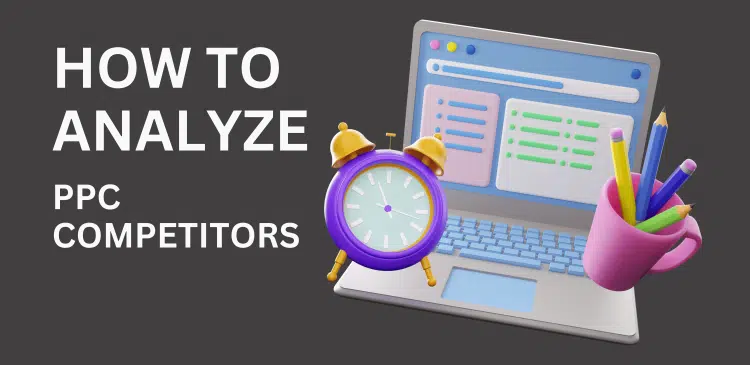How to Analyze Your PPC Competitors

The analysis of competitors is one of the necessary steps when implementing PPC advertising. It is important to clarify the reasons for conducting competitive analysis, as it provides essential information that can help enhance the strategy. This guide will assist you in analyzing your PPC competitors, featuring clear headings and subheadings to ensure a smooth flow of information for easy comprehension.
Step 1: Identify Your Competitors
The first thing that you should keenly identify is who your competitors are before you dig deeper into analysis. This is the first step that will enable any business to understand the competition they are up against in their respective industry.
Use Search Engine Results
Start by entering appropriate search terms concerning the product or service that you want to advertise to the search engine. Once again, observe the commercial links listed at the top and the left side of the Web page. These are direct competitors under the Pay Per Click model as they are likely to bid on the same keywords that you will bid on.
Explore Social Media Ads
Social media platforms like Facebook and Instagram also host PPC ads. To carry out this analysis, you may use these tools to identify which company is advertising similar products or a similar service. This may also help to broaden the concept of your potential competitors.
Leverage Third-Party Tools
As with most SEO tools, SEMrush, SpyFu and Ahref can be advisable for identifying the PPC competitors. The available keywords allow you to find out which keywords are being used by competitors as well as the CPC and ad scripts of the latter.
Step 2: Analyze Keywords and Bidding Strategies
The actual keywords and bidding they apply can give much information on what their strategies are, and what you should employ on your own.
Keyword Research
It is wise to use the same tools mentioned above to assess the keywords that your competitors are utilizing.
Pay attention to:
Popularity Insights: The following entails how frequent the keywords are searched for. Thus, high search volume means that the keyword is popular and competitive, and can still be very profitable.
Competition Level: How many of these businesses are using these keywords to advertise? This makes it easier for you to determine the competition level and set your bid correspondingly.
Bidding Strategies
Take an outline of your competitors’ bidding techniques to establish if they are using manual bidding, automatic bidding or both. It can also affect the price per click and consequently the results achieved through the ads of the firm.
Step 3: Review the Ad Copy
Analyze what ad copy and elements of creatives are equal to competitors and what might work with audiences.
Ad Copy Analysis
Pay attention to:
Important Headlines: Review headlines and to watch what keywords and phrases they use on their headline. This would help you in deciding on what you would like to make your ad headline.
Call-to-Action (CTA): One of your tasks should be to evaluate the CTAs of your competitors.
Value Proposition: This will enable any company involved to understand how competitors place their products or services in the market. What benefits are they highlighting?
Creative Elements
Analyzing the basic common points of the advertisements of your competitors:
Images and videos: If the images and videos have been used, check the quality and the relevance of the images or videos selected.
Type: Make note whether they are utilizing normal banners, responsive banners, or carousel banners. One may use different formats in the advertisements to increase the chances of prospects getting influenced.
Step 4: Landing Page and Ad Extensions
The page on which your competitor directs his users and the use of ad extensions are also crucial for analyzing their PPC tactics.
Landing Page Evaluation
Check if the landing page is:
Relevant: Is it in alignment with the advert and the associated words?
Accessibility: Is it easy to guide the visitors through getting them to become leads or customers?
Usability: Ensure that the page is optimized for SEO, also consider looking for call to action.
Ad Extensions
Remember to determine which of the mentioned ad extensions your competitors are involved in, including:
Website: Links that point to any part within the website such as different pages.
Callout Extensions: Definitions of shorter texts with the purpose of providing more detailed information regarding a certain separate element of the product.
Structured Snippets: Extra details concerning the services and products provided.
Step 5: Performance Metrics
The success and failure of competitor’s campaigns should be analyzed to get an outline of what should be done in the industry and what should not.
Click-Through Rate (CTR)
Evidently, a higher click-through rate means a higher quality or better ad copy and the ad creative in particular. Pay attention to how your competitors’ advertising works with regard to click through rate versus impressions.
Conversion Rate
As it represents the ratio of users who perform a particular action on the site after they have clicked the ad, this metric gives the percentage of people who clicked the ad. A high conversion rate means that the landing pages used and the offers presented are efficient.
Cost Per Acquisition (CPA)
It assists you to know the cost of obtaining a customer through PPC. Compare your CPA with that of your competitors to gauge efficiency.
Step 6: Monitor and Adapt
Regular Monitoring
To monitor these, you need to set some sort of a feed alert or do periodical check up to see any changes regarding your competitors. This may help you make some modifications and improve your own campaigns faster.
Adapt and Innovate
All in all, it is of the utmost importance to constantly update this approach, engage in new keyword tests, change bids, or redesign the ad creatives.
